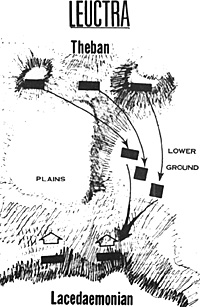 Well, then, what was Xenophon giving us--fact or fiction? In this case the old general was probably doing more arm-chair dreaming than an actual recounting of fact. But he was not doing it in a total vacuum. The idea of "wheeling wings" had already been prominent at the Battle of Mar-
athon, as well as several other Peloponese battles. For Xenophon though, it was the Battle of Leuctra (371 B.C.) which established the oblique wing or line as a tactical technique of devastating consequences. Here the record is quite clear. At Leuctra, a dispirited mixed Greek force of 6000 men, commanded by Epaminondas of Thebes stood in the way of an advancing disciplined professional Spartan army--10,000 strong.
Well, then, what was Xenophon giving us--fact or fiction? In this case the old general was probably doing more arm-chair dreaming than an actual recounting of fact. But he was not doing it in a total vacuum. The idea of "wheeling wings" had already been prominent at the Battle of Mar-
athon, as well as several other Peloponese battles. For Xenophon though, it was the Battle of Leuctra (371 B.C.) which established the oblique wing or line as a tactical technique of devastating consequences. Here the record is quite clear. At Leuctra, a dispirited mixed Greek force of 6000 men, commanded by Epaminondas of Thebes stood in the way of an advancing disciplined professional Spartan army--10,000 strong.
Yet what the Greeks lacked in numbers and quality they made up in a very talented leader. Instead of forming his battle line parallel to the enemy, Epaminondas inclined his right wing, largely composed of "unreliable allies," back some 45 degrees. Up front on his left he concentrated a fifty-shield-deep mass of crack troops.
With this formation he advanced obliquely towards the right corner of the Spartan line which was only 12 men deep. A quick computation of odds shows that at that contact point, per file of men, the Thebans outnumbered their enemy four to one. On any combat results table there is only one result: The defender is in trouble. So it was at Leuctra.
The Thebans began to roll up the Spartan line. The bewildered Spartans, with their King Cleombrotus fallen along side of hundreds of others, could do nothing. In order to avoid certain annihilation they made a hasty retreat, leaving behind some 4000 of their dead and captured. This battle which the Thebans had fully expected to lose convincingly proved the worth of the oblique line as a potent offensive tactical formation.
It marked in fact a minor turning point in Greek history. No longer was Sparta the power in the Peloponese. Thebes had ascended to that lofty but shaky position. In the process of course, a new battle tactic had been established.
In the subsequent years the oblique line undoubtedly entered the battle manuals--i.e., the heads--of all ancient world generals. Epaminondas himself used it again at the Battle of Mantinoea, nine years after Leuctra. It was probably used in many minor engagements but we have no definite proof for this, at least not until 331 B.C. In that year our next most famous example of the oblique line appeared at Arbela where Alexander of Macedon employed it to win an empire and gain his claim to the title "The Great."
More Oblique Line
Back to Table of Contents -- Panzerfaust #56
To Panzerfaust/Campaign List of Issues
To MagWeb Master Magazine List
© Copyright 1972 by Donald S. Lowry.
This article appears in MagWeb (Magazine Web) on the Internet World Wide Web.
Other military history articles and gaming articles are available at http://www.magweb.com